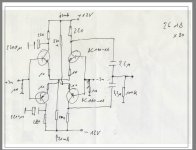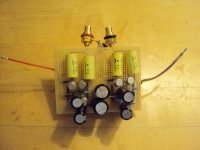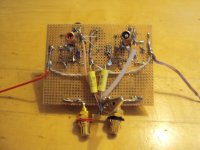wooo...this is bad!! Need help!!
I was going to buy the curve tracer today, looking on ebay I can't find it anymore!!
Can somebody here help?
locky_z's Intelligent curve tracer
I was going to buy the curve tracer today, looking on ebay I can't find it anymore!!
Can somebody here help?
locky_z's Intelligent curve tracer
Hi,
as for post-regulation and filtering I like to use gyrators.
Keantoken has posted a very interesting CFP-Gyrator here at DIY (see his signature) which excels in extremely low output impedance.
Beeing a Gyrator it keeps the Zout over a very wide bandwidth. Any rise of Zout in the MHz range will then be swamped by a small Cap.
It´d be nice to see how such a simple integrated Reg, assisted by a CFP-G would perform.
jauu
Calvin
as for post-regulation and filtering I like to use gyrators.
Keantoken has posted a very interesting CFP-Gyrator here at DIY (see his signature) which excels in extremely low output impedance.
Beeing a Gyrator it keeps the Zout over a very wide bandwidth. Any rise of Zout in the MHz range will then be swamped by a small Cap.
It´d be nice to see how such a simple integrated Reg, assisted by a CFP-G would perform.
jauu
Calvin
wooo...this is bad!! Need help!!
I was going to buy the curve tracer today, looking on ebay I can't find it anymore!!
Can somebody here help?
locky_z's Intelligent curve tracer
This seller currently has no items for sale 🙂 eBay My World - locky_z I'm sure he will be back (I think). Also check this thread http://www.diyaudio.com/forums/solid-state/151253-diy-curve-tracer-pc-38.html#post3478245
I have an unfinshed kit from Locky, do you want it ??
thanks for the offer, but due to lack of time as you might imagine, I need the finished and tested product.
Thanks anyway for the offer.
This seller currently has no items for sale 🙂 eBay My World - locky_z I'm sure he will be back (I think). Also check this thread http://www.diyaudio.com/forums/solid-state/151253-diy-curve-tracer-pc-38.html#post3478245
yes I noticed that.
I saw he sold the last one today!!!

I also contacted him through ebay and through the forum, hope he will reply soon.
I definitely need a curve tracer to create a proper built of the first prototype.

Hi,
as for post-regulation and filtering I like to use gyrators.
Keantoken has posted a very interesting CFP-Gyrator here at DIY (see his signature) which excels in extremely low output impedance.
Beeing a Gyrator it keeps the Zout over a very wide bandwidth. Any rise of Zout in the MHz range will then be swamped by a small Cap.
It´d be nice to see how such a simple integrated Reg, assisted by a CFP-G would perform.
jauu
Calvin
Interesting thought!!
I was planning for this design to power it up by battery and new shunt design to improve noise performance.
No.
There was a listening test on PSUs in Linear Audio.
They used a rather simple Borbely line stage that did not have much PSU rejection.
The outcome was rather suprising.
The Jung-Didden series regulator did best and the Salas shunt did quite poor.
Usually a shunt should work better but that was not the case here.
So a search was undertaken why that was.
A distortion analysis by FFT of the output voltage correlated with the sound impressions.
The PSUs that did not have high order distortion artifacts did best.
Surprising indeed, I would really like to know what type of vref was used in salas reg and what was it's version...
Also found these graphs in Didden's page that indicate quite low noise and ripple ejection with one salas shunt (what type?)
http://www.linearaudio.net/images/letters.pdf/V4 JW F5.pdf
http://www.linearaudio.net/images/letters.pdf/V4 JW F7.pdf
Online Articles
Fortunately locky listed it again....I am going to purchase it now!! 😎😎
That way I will be able to precisely match devices and believe it or not the phono will sound even better!!!!
Not want to jump to conclusion too fast, but as I am breaking in the new caps, the sound of the phono is certainly the best I have heard so far from any commercial and non phono I have ever auditioned.
It is a pretty dangerous statement as many things are set up dependant...but anyway for as much as it is worth this my two cents!! 😀
😎
That way I will be able to precisely match devices and believe it or not the phono will sound even better!!!!
Not want to jump to conclusion too fast, but as I am breaking in the new caps, the sound of the phono is certainly the best I have heard so far from any commercial and non phono I have ever auditioned.
It is a pretty dangerous statement as many things are set up dependant...but anyway for as much as it is worth this my two cents!! 😀
😎
When you like it you like it, fine with me.
That is what it is all about.
I am also very curious how i will like it.
As i told you i already have tried the input stage and it sounded great.
That is what it is all about.
I am also very curious how i will like it.
As i told you i already have tried the input stage and it sounded great.
When you like it you like it, fine with me.
That is what it is all about.
I am also very curious how i will like it.
As i told you i already have tried the input stage and it sounded great.
Hi Joachim, could you post only the schematic of MC pre-pre with bipolar transistor input?
TIA
Felipe
Here is the basic structure of the input gain cell. It looks very simple on the surface but works better then expected. The way i have drawn it, it is made for battery supply.
There can be many improvements being made, better PSU rejection by CCSs, lower noise etc. but try this before you draw conclusions.
There can be many improvements being made, better PSU rejection by CCSs, lower noise etc. but try this before you draw conclusions.
Attachments
When you like it you like it, fine with me.
That is what it is all about.
I am also very curious how i will like it.
As i told you i already have tried the input stage and it sounded great.
ahahah you are a funny guy!!!!
When moment comes, hopefully you will like it too!! It is too early to try it there is more work to do on it still!!!
Take your time. In Germany we say : power comes out of silence.
I will post pictures of my prototype input stage soon.
I will post pictures of my prototype input stage soon.
Take your time. In Germany we say :
Auf die Dauer, hilft nur Power.
Here is the basic structure of the input gain cell. It looks very simple on the surface but works better then expected. The way i have drawn it, it is made for battery supply.
There can be many improvements being made, better PSU rejection by CCSs, lower noise etc. but try this before you draw conclusions.
Here are the pictures....
Thank you very much Joachim🙂
Wich Hfe the max. possible and all matcheds?
Last edited:
Thank you very much Joachim🙂
Wich Hfe the max. possible and all matcheds?
it depends what you are going to use the input stage for and how, bal/in bal/out or unbal/out?
Hiugh gain stage, simple low gain preamp?
If you are using it like I do on masterpiece, yes you want to have high hfe and high match too.
Hope this helps.
Hfe is not very high in this stone old BCs and it is not necessary in this circuit.
I chose them because they have very low noise and they are very symmetrical.
I was especially pleased with the high early voltage of the PNP up to high currents so this circuit can be driven with 10mA on each transistor. This lowers the voltage noise.
At the price of a bit more distortion the emitter resistors can be cut in half and also the collector resistors for a 3dB noise reduction.
DC cancels at the input to a high degree. The circuit also does bal-unbal conversion.
Yes, i matched Hfe. I can not remember but it was between 150 and 200.
I chose them because they have very low noise and they are very symmetrical.
I was especially pleased with the high early voltage of the PNP up to high currents so this circuit can be driven with 10mA on each transistor. This lowers the voltage noise.
At the price of a bit more distortion the emitter resistors can be cut in half and also the collector resistors for a 3dB noise reduction.
DC cancels at the input to a high degree. The circuit also does bal-unbal conversion.
Yes, i matched Hfe. I can not remember but it was between 150 and 200.
- Status
- Not open for further replies.
- Home
- Source & Line
- Analogue Source
- Masterpiece


